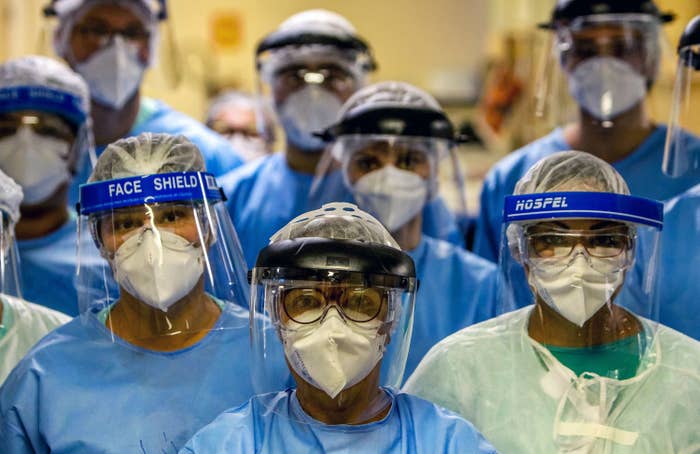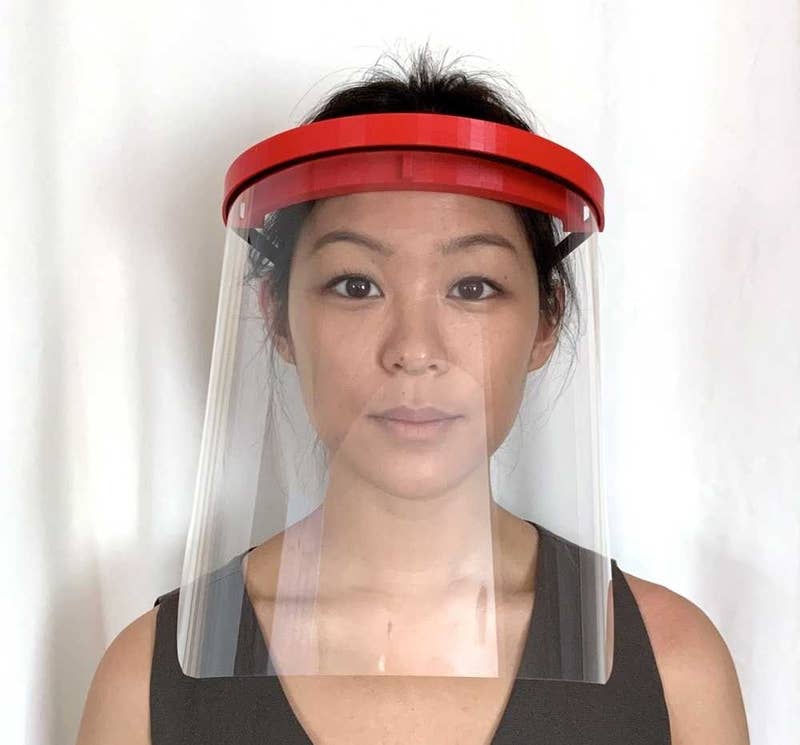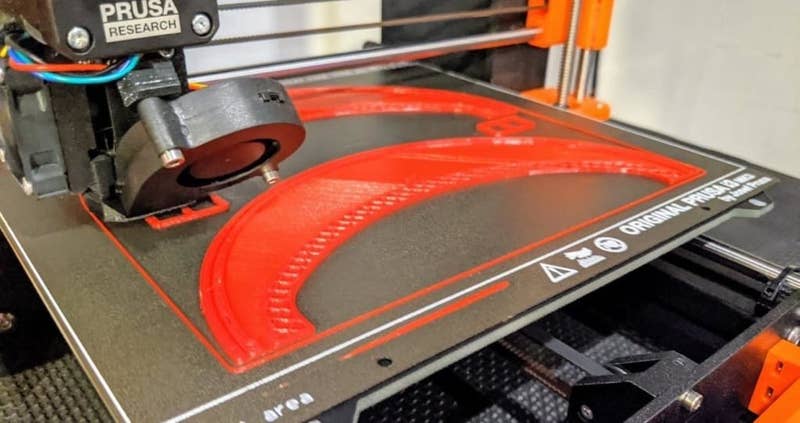ER doctor Tarek Loubani has printed around 1,000 face shields during the coronavirus crisis, working in his spare time from his basement.
Megha Rajagopalan BuzzFeed News Reporter
Reporting From London Posted on April 17, 2020

Silvio Avila / Getty Images
Doctors wear face shields in the ICU of the Hospital de Clinicas in Porto Alegre, Brazil.
LONDON — Tarek Loubani has spent years 3D-printing simple medical devices with a team of engineers to help patients in the Gaza Strip, one of the toughest places in the world to source medical equipment.
But now the coronavirus pandemic has left hospitals around the world short of the most basic medical supplies, and Loubani, an ER doctor, is printing face shields back home in Canada.
Loubani has so far printed 1,000 face shields in two weeks, working mostly by himself from the basement of his house in London, Ontario.
The 39-year-old describes himself as “one of your friends who was a geek in his basement in high school.”
“I always really enjoyed technology, and I always would look at it and try to imagine what I could do with it,” he said.
If you're someone who is seeing the impact of the coronavirus firsthand, we’d like to hear from you. Reach out to us via one of our tip line channels.

The Glia Project
An employee at the Glia Project wearing a 3D-printed face shield.
Loubani, along with a group of engineers and other doctors, started an organization in 2013 called the Glia Project that 3D-prints medical supplies. He came up with the idea while working in Gaza — a place where hospitals frequently lack basic medical and surgical supplies in part because of an Israeli and Egyptian blockade. (Loubani has worked in the region on and off since 2011.)
Hospitals around the world, including in North America, are currently grappling with shortages of personal protective equipment (PPE), including face shields, which medical personnel depend on during the pandemic. While 3D printing doesn’t represent a scalable solution to the problem, Loubani’s efforts to make face shields — along with other individuals and organizations using 3D printing to address shortages — underscores the desperate need.
The face shields he has made have been sold to a local hospital, and also online to customers in Canada and elsewhere, all for a nominal fee. (His organization is licensed to produce the shields under Canadian regulatory standards.) He produces them in his downtime, when he is not working long shifts at the hospital.
Loubani was working at a hospital in Gaza when he came up against a problem he’d never encountered before: Though the doctors he worked with were highly trained, they simply could not access basic medical equipment. Hospitals would try to order even something as simple as a stethoscope, but found they would take months to arrive, or never show up at all.
“The stethoscope is such a simple piece of equipment,” he said. “But you lose a few pieces and suddenly you have just doubled the cost.” In Gaza, where UN authorities have said the health care system is close to collapse, it was unsustainable.

Lillian Suwanrumpha / Getty Images
A nurse holds a newborn baby wearing a face shield at Praram 9 Hospital in Bangkok, Thailand.
Loubani said hospital officials in Gaza tried offering bribes and even smuggling equipment, but this proved expensive and unreliable.
“We just couldn’t get medical equipment in,” he said. “I learned if you can’t make it, you can’t depend upon it.”
Loubani had bought a 3D printer to tinker with before he first went to Gaza in 2011 to train doctors and practice medicine.
“Open-source 3D printers had just hit the market and they were terrible,” he recalled. “I remember when we started trying to print, it took a lot of time for the tech to catch up with the ideas.”
“I found engineers who were really interested in the work,” he said. “There were a few of us who were into this, and we started working on it.” Some of his collaborators were Palestinian; others were from Canada and Europe.
He wondered if 3D printing — back then a far less sophisticated technology — could help produce stethoscopes and other tools for hospitals in Gaza.
Together they founded the Glia Project, which publishes open-source plans for printing medical hardware. Their goal is to expand access to these tools for everyone in need.

The Glia Project
Loubani sees 3D-printing face shields as a way to contribute to the fight against COVID-19, the disease caused by the coronavirus.
3D printing isn’t a catchall solution. Martin Culpepper, a professor of mechanical engineering at MIT, pointed out in a recent interview that masks and face shields would have to be made from materials that are compatible with sterilization techniques and the medical devices that hospitals use, meaning that the person making the items would need a degree of expertise or medical contacts.
“The sheer volume of the need is another reason we are discouraging the use of 3D printing to produce PPE on MIT’s campus,” said Culpepper. “Some hospitals need thousands of pieces of PPE each day, 3D printing just cannot keep up with that demand.”
But 3D printing has already saved lives in the fight against the coronavirus. When a hospital in Italy ran out of respirator valves needed to connect patients to breathing machines, a company stepped in and printed 100 of them within 24 hours.
Loubani said 3D printing is too slow and energy-intensive to be good for mass manufacturing face shields. But he said that it could fill in holes where big manufacturers have lagged.
“People with 3D printers can fill this immediate change in need and lack of supply until the big boys and girls can retool and start the supply.”

MORE ON THIS
These Nurses Were Suspended For Refusing To Work With Coronavirus Patients Without N95 Masks
Reporting From London Posted on April 17, 2020

Silvio Avila / Getty Images
Doctors wear face shields in the ICU of the Hospital de Clinicas in Porto Alegre, Brazil.
LONDON — Tarek Loubani has spent years 3D-printing simple medical devices with a team of engineers to help patients in the Gaza Strip, one of the toughest places in the world to source medical equipment.
But now the coronavirus pandemic has left hospitals around the world short of the most basic medical supplies, and Loubani, an ER doctor, is printing face shields back home in Canada.
Loubani has so far printed 1,000 face shields in two weeks, working mostly by himself from the basement of his house in London, Ontario.
The 39-year-old describes himself as “one of your friends who was a geek in his basement in high school.”
“I always really enjoyed technology, and I always would look at it and try to imagine what I could do with it,” he said.
If you're someone who is seeing the impact of the coronavirus firsthand, we’d like to hear from you. Reach out to us via one of our tip line channels.

The Glia Project
An employee at the Glia Project wearing a 3D-printed face shield.
Loubani, along with a group of engineers and other doctors, started an organization in 2013 called the Glia Project that 3D-prints medical supplies. He came up with the idea while working in Gaza — a place where hospitals frequently lack basic medical and surgical supplies in part because of an Israeli and Egyptian blockade. (Loubani has worked in the region on and off since 2011.)
Hospitals around the world, including in North America, are currently grappling with shortages of personal protective equipment (PPE), including face shields, which medical personnel depend on during the pandemic. While 3D printing doesn’t represent a scalable solution to the problem, Loubani’s efforts to make face shields — along with other individuals and organizations using 3D printing to address shortages — underscores the desperate need.
The face shields he has made have been sold to a local hospital, and also online to customers in Canada and elsewhere, all for a nominal fee. (His organization is licensed to produce the shields under Canadian regulatory standards.) He produces them in his downtime, when he is not working long shifts at the hospital.
Loubani was working at a hospital in Gaza when he came up against a problem he’d never encountered before: Though the doctors he worked with were highly trained, they simply could not access basic medical equipment. Hospitals would try to order even something as simple as a stethoscope, but found they would take months to arrive, or never show up at all.
“The stethoscope is such a simple piece of equipment,” he said. “But you lose a few pieces and suddenly you have just doubled the cost.” In Gaza, where UN authorities have said the health care system is close to collapse, it was unsustainable.

Lillian Suwanrumpha / Getty Images
A nurse holds a newborn baby wearing a face shield at Praram 9 Hospital in Bangkok, Thailand.
Loubani said hospital officials in Gaza tried offering bribes and even smuggling equipment, but this proved expensive and unreliable.
“We just couldn’t get medical equipment in,” he said. “I learned if you can’t make it, you can’t depend upon it.”
Loubani had bought a 3D printer to tinker with before he first went to Gaza in 2011 to train doctors and practice medicine.
“Open-source 3D printers had just hit the market and they were terrible,” he recalled. “I remember when we started trying to print, it took a lot of time for the tech to catch up with the ideas.”
“I found engineers who were really interested in the work,” he said. “There were a few of us who were into this, and we started working on it.” Some of his collaborators were Palestinian; others were from Canada and Europe.
He wondered if 3D printing — back then a far less sophisticated technology — could help produce stethoscopes and other tools for hospitals in Gaza.
Together they founded the Glia Project, which publishes open-source plans for printing medical hardware. Their goal is to expand access to these tools for everyone in need.

The Glia Project
Loubani sees 3D-printing face shields as a way to contribute to the fight against COVID-19, the disease caused by the coronavirus.
3D printing isn’t a catchall solution. Martin Culpepper, a professor of mechanical engineering at MIT, pointed out in a recent interview that masks and face shields would have to be made from materials that are compatible with sterilization techniques and the medical devices that hospitals use, meaning that the person making the items would need a degree of expertise or medical contacts.
“The sheer volume of the need is another reason we are discouraging the use of 3D printing to produce PPE on MIT’s campus,” said Culpepper. “Some hospitals need thousands of pieces of PPE each day, 3D printing just cannot keep up with that demand.”
But 3D printing has already saved lives in the fight against the coronavirus. When a hospital in Italy ran out of respirator valves needed to connect patients to breathing machines, a company stepped in and printed 100 of them within 24 hours.
Loubani said 3D printing is too slow and energy-intensive to be good for mass manufacturing face shields. But he said that it could fill in holes where big manufacturers have lagged.
“People with 3D printers can fill this immediate change in need and lack of supply until the big boys and girls can retool and start the supply.”

These Nurses Were Suspended For Refusing To Work With Coronavirus Patients Without N95 Masks
Emmanuel Felton · April 16, 2020
Hannah Al-Othman · April 16, 2020

Megha Rajagopalan is a world correspondent for BuzzFeed News and is based in the Middle East.

Megha Rajagopalan is a world correspondent for BuzzFeed News and is based in the Middle East.

No comments:
Post a Comment